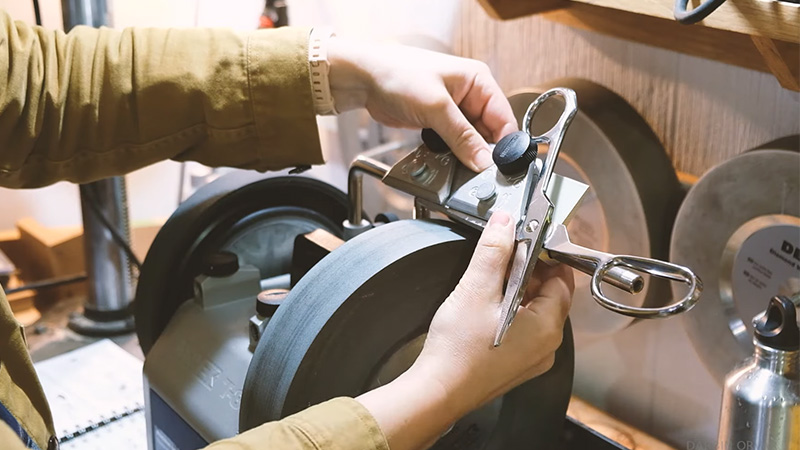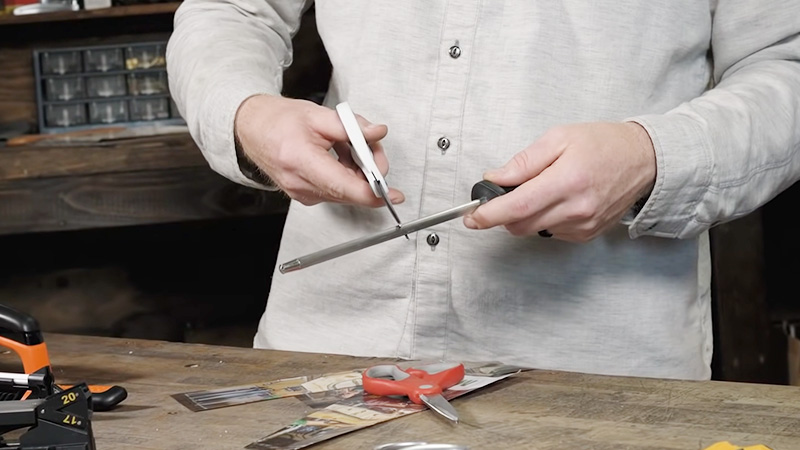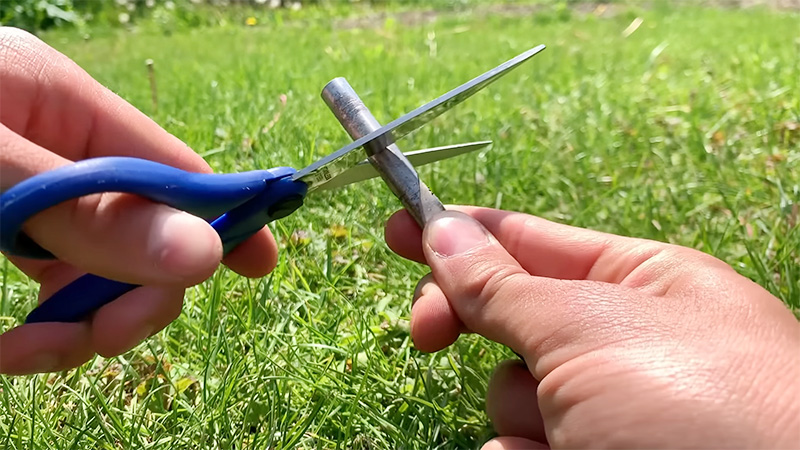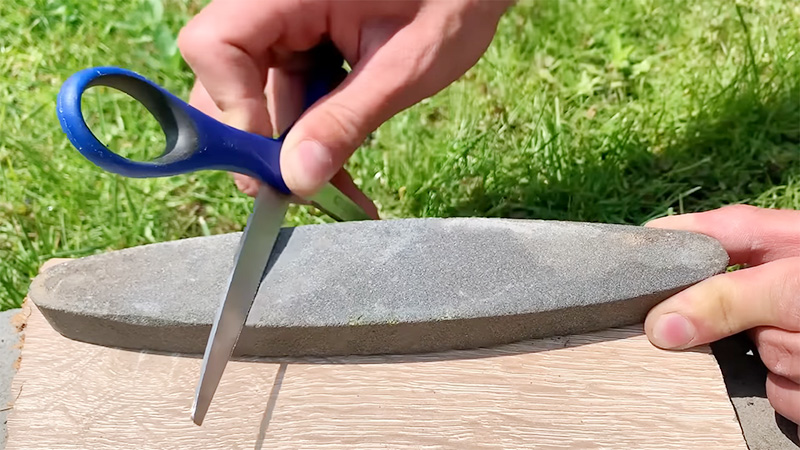Scissors are essential tools in every household and workspace, serving us in a myriad of tasks from crafting and sewing to kitchen chores and office work. Over time, even the finest pair of scissors can lose their sharpness, leading to frustration and less-than-precise cuts.
The good news is that you don’t need to replace your dull scissors. Learning how to sharpen them can bring their cutting-edge back to life, saving you money and ensuring your tools remain reliable.
In this comprehensive guide, we will discuss how to sharpen scissors with ease. Whether you’re a professional crafter, a home chef, or someone who simply values a well-maintained toolbox, understanding the art of scissor sharpening is a valuable skill.
Join us as we explore various methods, tools, and techniques to keep your scissors sharp and ready for any task. Say goodbye to frustration and hello to precision cuts once more!

How to Sharpen Scissors?
Sharpening scissors is a useful skill that can extend the life of your cutting tools. Here’s a step-by-step guide on how to sharpen scissors:
Materials You’ll Need
- Dull scissors
- A sharpening stone or a honing rod
- A damp cloth
- A screwdriver (if your scissors have removable blades)
Prepare the Scissors
Start by cleaning the scissors. Use a damp cloth to wipe away any dirt, debris, or built-up residue on the blades.
Disassemble If Necessary
Some scissors have removable blades held together by a screw. If your scissors have this feature, use a screwdriver to carefully remove the blades for easier sharpening. Remember to keep track of which blade goes where for reassembly.
Choose Your Sharpening Tool
You can use either a sharpening stone or a honing rod (also known as a sharpening steel) for this task. A sharpening stone is ideal for more extensive sharpening, while a honing rod is better for quick touch-ups.
Sharpen with a Sharpening Stone
Wet the sharpening stone with water or honing oil according to the manufacturer’s instructions. Hold one blade of the scissors firmly against the stone at a 20-degree angle.
Move the blade along the stone’s surface in a sweeping motion, starting from the base of the blade and moving towards the tip.
Repeat this process several times, maintaining the same angle and applying even pressure to sharpen the entire length of the blade. Flip the scissors over and repeat the process on the other blade.
Sharpen with an Honing Rod
Hold the honing rod vertically with the tip resting on a stable surface. Place one blade of the scissors against the honing rod at a 20-degree angle.
Slide the blade along the rod, starting from the base and moving towards the tip. Maintain consistent pressure and repeat this motion several times. Flip the scissors over and repeat the process on the other blade.
Reassemble and Test
If you disassembled the scissors, carefully reassemble them, making sure the blades are correctly aligned. Test the scissors by cutting a piece of paper or fabric to see if they are cutting smoothly and cleanly. If not, repeat the sharpening process.
Maintain Regularly
To keep your scissors sharp, hone them with a honing rod regularly, and perform more extensive sharpening with a sharpening stone as needed.
With this guide, you can keep your scissors in top-cutting condition, ensuring they remain effective for various tasks around the home or in your crafting projects.
How Do You Sharpen Scissors with a Steel Knife?

Sharpening scissors with a steel knife, also known as a honing rod or sharpening steel, can be done to maintain the edge of your scissors between more extensive sharpening sessions. Here’s how to do it:
Materials You’ll Need
- Dull scissors
- A honing rod (steel knife)
- A damp cloth
Prepare the Scissors
Start by cleaning the scissors. Use a damp cloth to wipe away any dirt, debris, or built-up residue on the blades.
Hold the Honing Rod
Hold the honing rod (steel knife) vertically with the tip resting on a stable surface, like a countertop or cutting board.
Position the Scissors
Open the scissors fully so that the blades are separated. Place one blade of the scissors against the honing rod at a 20-degree angle. You can estimate this angle by matching the existing bevel angle of the scissors.
Slide the Scissors Along the Rod
Slide the blade along the honing rod, starting from the base of the blade and moving towards the tip. Maintain consistent and gentle pressure.
Repeat this motion several times, honing the entire length of the blade. Make sure to maintain the 20-degree angle throughout.
Flip and Repeat
Flip the scissors over to the other blade. Repeat the honing process for the second blade, again ensuring that you maintain the correct angle.
Test the Scissors
After honing both blades, test the scissors by cutting a piece of paper or fabric. You should notice an improvement in their cutting performance.
Maintenance
Regularly hone your scissors with a honing rod to keep the blades aligned and the edge sharp. If your scissors become very dull, consider using a sharpening stone for more extensive sharpening.
Sharpening scissors with a honing rod helps maintain their cutting edge and can prolong the time between more thorough sharpening sessions. It’s a handy technique for keeping your scissors in good working condition for various tasks.
When Do Scissors Need Sharpening?

Scissors should be sharpened when they exhibit the following signs of dullness or reduced cutting performance:
Blunt Cuts
If your scissors struggle to cut cleanly through materials they once easily sliced, it’s a clear indication that they need sharpening. Dull scissors tend to crush, tear, or bend the material rather than making sharp, precise cuts.
Increased Effort
When you find yourself exerting more force or effort than usual to cut through materials, it’s time to sharpen your scissors. Sharp scissors should cut with minimal effort.
Snags or Pulls
If your scissors are snagging on fabric threads or getting stuck while cutting paper, they are no longer functioning at their best. A sharp pair of scissors should smoothly glide through materials.
Uneven or Jagged Edges
Inspect the edges of your scissors’ blades. If you notice nicks, chips, or uneven wear along the cutting edges, it’s a clear sign that sharpening is needed. These imperfections can affect the quality of your cuts.
Frayed Edges
When cutting fabric, if you notice that the edges become frayed or unraveled instead of cleanly cut, your scissors are due for sharpening. Sharp scissors should leave neat, fray-free edges.
Slippage
If the blades of your scissors tend to slip past each other rather than meeting and cutting efficiently, it’s a sign of blade misalignment and bluntness.
Reduced Precision
For crafters and artists, precision is crucial. If you notice that your scissors are no longer providing the fine control you need for detailed work, it’s time to sharpen them.
Inconsistent Cuts
If you’re getting inconsistent results when cutting, such as uneven edges or varying degrees of fraying, it’s a sign that the scissors need sharpening to ensure uniform cuts.
Regular maintenance, such as honing with a honing rod or steel knife, can help prolong the time between full sharpening sessions.
However, when you observe any of the above signs of reduced cutting performance, it’s a clear indication that it’s time to sharpen your scissors to restore their functionality and precision.
What Other Tools Are Used to Sharpen Scissors?

In addition to using sharpening stones and honing rods (or steel knives), there are a few other tools and methods you can use to sharpen scissors:
Scissor Sharpeners
There are manual and electric scissor sharpeners specifically designed for sharpening scissors. These devices have slots or guides that help you maintain the correct angle while sharpening the blades. Electric sharpeners can be especially efficient.
Emery Cloth or Sandpaper
Emery cloth or fine-grit sandpaper can be used to remove minor nicks and burrs from scissor blades. Fold the emery cloth or sandpaper and cut through it with the scissors several times, ensuring that the blades make full contact with the abrasive surface.
Aluminum Foil
Fold a sheet of aluminum foil multiple times to create several layers. Then, cut through the foil with your scissors. The abrasive action of cutting through the foil can help smooth out minor imperfections on the blade edges.
Sharpening Kits
Some scissor sharpening kits are available, which may include specialized sharpening stones or abrasive tools designed for scissors. These kits often come with detailed instructions for sharpening different types of scissors.
Professional Sharpening Services
If you’re uncertain about sharpening your scissors yourself or if they require more extensive sharpening, you can seek the services of a professional sharpening expert. They have the tools and expertise to sharpen scissors effectively and restore them to like-new condition.
When choosing a method or tool to sharpen your scissors, consider the level of dullness or damage your scissors have sustained. For regular maintenance and minor touch-ups, honing with a honing rod or using an emery cloth may suffice.
However, for more significant sharpening needs, specialized scissor sharpeners or professional services are often recommended to achieve the best results.
FAQs
The frequency of sharpening depends on how often you use your scissors and the materials you cut. As a general guideline, sharpening every six months to a year is suitable for most household scissors.
While it’s possible to use some knife sharpeners on scissors, it’s not ideal. Scissor sharpeners are designed with specific angles and guides to ensure proper sharpening of scissor blades.
Using a dedicated scissor sharpener or method is recommended for the best results.
The ideal angle for sharpening scissors is typically around 20 degrees. You can estimate this angle by matching the existing bevel angle of your scissors. Use a sharpening tool with a guide or following manufacturer instructions for your specific tool.
Serrated scissors and pinking shears have specialized blade designs that make them challenging to sharpen at home. It’s usually best to leave the sharpening of these types of scissors to professionals with expertise and equipment to maintain their unique edges.
Yes, safety is important when sharpening scissors. Always follow the manufacturer’s instructions for the sharpening tool you’re using. Wear safety goggles to protect your eyes from any metal particles that may be generated during the sharpening process.
Conclusion
As you’ve discovered, sharpening scissors is a practical skill that can extend the lifespan of your trusted cutting tools. By following the methods and tips outlined in this guide, you can revive dull scissors, saving money and reducing waste.
Remember, the key to successful scissor sharpening lies in patience and practice. Whether you choose the classic sharpening stone, specialized scissor sharpeners, or even DIY methods like aluminum foil, maintaining the cutting edge of your scissors is within reach for everyone.
With sharp scissors at your disposal, you’ll not only enjoy smoother and more precise cuts but also experience a renewed sense of satisfaction in your various tasks, from crafting to cooking to everyday chores.
So, grab your scissors, choose your preferred sharpening method, and keep those blades sharp and ready for action. Happy cutting!
Leave a Reply